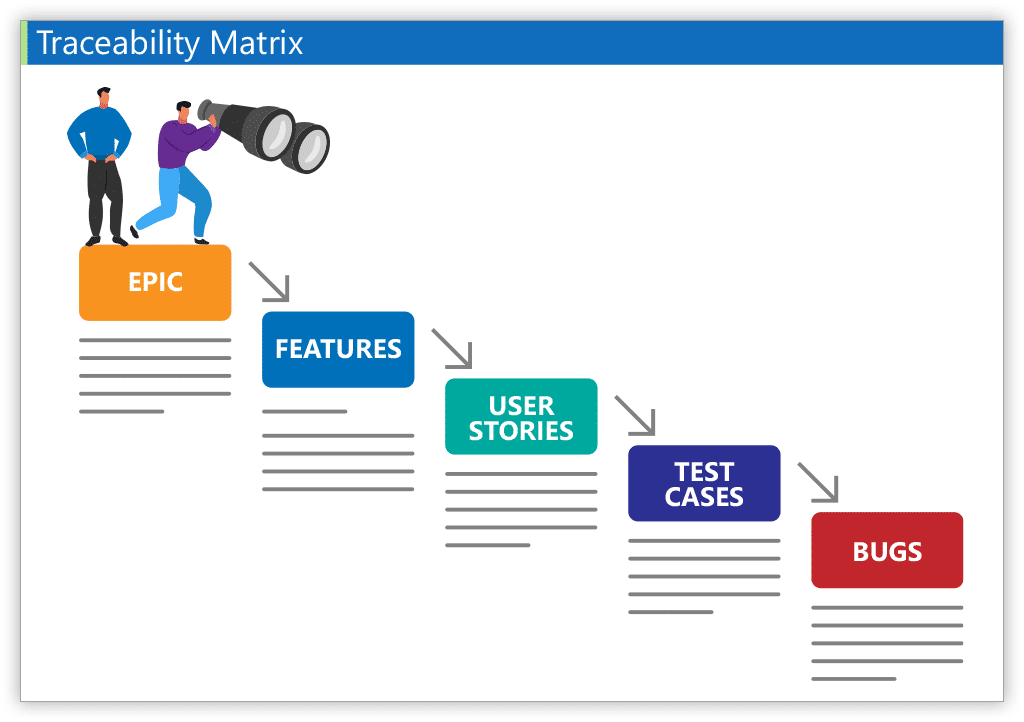Traceability Matrices
Common Questions and Tutorials
Traceability Matrices
Introduction to Traceability Matrices

What is a Requirements Traceability Matrix (RTM)?
A Requirements Traceability Matrix is a tool that provides teams with the ability to easily trace requirements from end-to-end.
This means you are able to trace how higher level requirements (like Epics) trace all the way down to your lowest level requirements (like bugs). Teams can use our two matrices covered in these tutorials to build end-end traceability and also to create Test Case coverage, discover orphaned requirements, and manage the relationships between requirements!
Tutorials
Building a Work Item Type Horizontal Matrix
Traceability Matrices in Azure DevOps
Building a Horizontal Requirements Traceability Matrix is a method of seeing the full end-to-end perspective of your project.
Traditionally these Matrices take hours or days to create manually.
In our live demos we show teams how they can build the same style of matrix in roughly 15 seconds. In this video you learn everything you need to build these matrices using simple Work Item types.
Building Query and Multiple Query Horizontal Matrices
Traceability Matrices in Azure DevOps
In this tutorial we cover how your team can populate matrices using the results of Queries. This allows you to pull in any subset of data, and easily visualize the relationships between these work items.
Building a Work Item Type Intersection Traceability Matrix
Traceability Matrices in Azure DevOps
The Intersection Requirements Traceability Matrix allows you to identify and manage the relationships between the requirements in your project.
You can easily use this matrix to update relationships in your project, identify orphaned requirements, and ensure Test Coverage. This video shows you how to create an Intersection RTM using the work items from your project.
Building a Query Intersection Matrix
Traceability Matrices in Azure DevOps
When pulling in the information for your Intersection RTM, you might want to visualize one-to-many or many-to-many relationships. The only way to do this is to populate the columns and rows of your Intersection RTM using queries.
Watch this tutorial to find out more.
Extra Videos
Showing Test Results Within a Traceability Matrix
Building Documents in Azure DevOps
Do you already have a Work Item hierarchy in your backlog that you would like to add to your Smart Doc quickly? Watch this video to see how you can drag a full Work Item hierarchy into a Smart Doc at once.
Common Questions
About Requirements Traceability Matrices
A Traceability Matrix is a tool with many functions and many benefits.
Traceability Matrices allow teams to visualize their requirements in a hierarchy, they allow teams to identify disconnected and orphaned requirements, and provide you with an an extra level of auditability.
Modern Requirements uses two types of Tracebility Matrices:
- Horizontal Traceability Matrix
- Intersection Traceability Matrix
Both of these are described below.
Horizontal Matrices allow teams to easily identify issues using a broader perspective.
This type of Matrix can be used to show you your requirements hierarchy and how higher-level work items, like Epics, decompose down into lower-level requirements, like Test Cases and Bugs.
This matrix can also be exported to Excel and saved for auditability purposes if necessary.
Intersection Matrices are used to quickly and easily manage, updated, and change the relationships between two sets of work items.
By hosting one set of requirements on the row, and another set on the column, teams can easily understand the relationships these sets of requirements currently have.
The Intersection Matrix allows you to easily update the relationships between two work items by adding a relationship where they intersect.
This will allow you to increase coverage Requirements and their Test Cases, identify orphaned requirements and more.
Yes.
The Intersection Matrix will reflect any current relationships that exist between two work items.
Yes, that is what it is built for.
In fact, the Intersection Matrix is objectively the fastest way to build relationships between two work items in Azure DevOps.
In both types of Matrices, you can choose what information you are bringing into the matrix.
You can choose to build Matrices by picking work items from a specific iteration or area path, or you can use Queries to gather exactly what information you want brought in.
Subscribe to our Monthly Newsletter!


